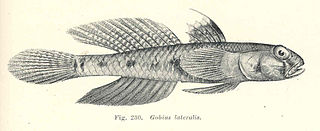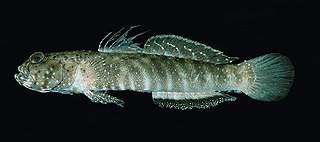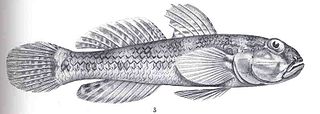
Favonigobius is a genus of gobies native to fresh, brackish and marine waters around the Indian Ocean and the western Pacific Ocean. Commonly called "sand gobies", this term more alternatively refers to the family Kraemeriidae, a relative of the true gobies.

Exyrias is a genus of gobies mostly native to marine waters of the Indian Ocean and the western Pacific Ocean with one freshwater species (E. volcanus) known from the Philippines.

Pomatoschistus is a genus of gobies native to fresh, brackish and marine waters of Europe, the eastern Atlantic Ocean and the Mediterranean Sea.
Silhouettea is a genus of gobies native to the Indian Ocean and the western Pacific Ocean. The name of this genus refers to the island of Silhouette in the Seychelles where the type specimens of the type species, Silhouettea insinuans, were collected.
Taenioides is a genus of gobies native to fresh, brackish, and marine waters of the coastal areas of the Indian Ocean and the western Pacific Ocean.

The Gobiiformes are an order of fish that includes the gobies and their relatives. The order, which was previously considered a suborder of Perciformes, is made up of about 2,211 species that are divided between seven families. Phylogenetic relationships of the Gobiiformes have been elucidated using molecular data. Gobiiforms are primarily small species that live in marine water, but roughly 10% of these species inhabit fresh water. This order is composed chiefly of benthic or burrowing species; like many other benthic fishes, most gobiiforms do not have a gas bladder or any other means of controlling their buoyancy in water, so they must spend most of their time on or near the bottom. Gobiiformes means "Goby-like".

Coryphopterus glaucofraenum, the bridled goby, is a species of goby native to the Western Atlantic Ocean and the Caribbean Sea from North Carolina to Brazil. It can be found on reefs at depths of from 2 to 45 metres in areas of white sand. This species can reach a length of 8 centimetres (3.1 in) TL. It occasionally makes its way into the aquarium trade.

Chromogobius is a small genus of gobies native to the eastern Atlantic Ocean through the Mediterranean and Adriatic seas to the Black Sea.

Lesueurigobius is a genus of gobies native to the eastern Atlantic Ocean. The generic name honours the French naturalist Charles Alexandre Lesueur (1778-1846), for whom the type species, Lesueurigobius suerii, was named, Georg Duncker's name Lesueuria being preoccupied by a genus of comb jellies.

Koumansetta is a small genus of gobies native to the Indian Ocean and the western Pacific Ocean. The name of this genus honours the Dutch ichthyologist and goby taxonomist Frederik Petrus Koumans (1905-1977) of the Rijksmuseum van Natuurlijke Historie in Leiden, Netherlands, who had written a description of Koumansetta rainfordi following a visit to the Australian Museum in Sydney in 1938 but did not name it. The outbreak of World War II meant that Whitley's correspondence with Koumans was interrupted, so he named this genus after him, noting “which will enshrine memories of happier days of our meetings in Leiden and Sydney”.
Coryphopterus is a genus of gobies mostly found in the western Atlantic Ocean though a couple species are found in the Indian and/or Pacific oceans.

Cryptocentroides is a genus of gobies native to the western Indian Ocean and the western Pacific Ocean.
Feia is a genus of gobies native to shallow coastal waters of the Indian Ocean and the western Pacific Ocean.
Lebetus is a genus of gobies native to the eastern Atlantic Ocean.

The wolfsnout goby, also known as the dognsout goby or cup-sponge goby, is a species of goby native to the Indian Ocean and the western Pacific Ocean. This species lives on large fan-shaped or floppy sponges, particularly Phyllospongia foliascens and Phyllospongia papyracea, growing on reefs at depths down to 15 metres (49 ft). This species grows to a length of 3.5 centimetres (1.4 in) SL. This species is the only known member of its genus. It spans benthically and is a solitary species.

Paragobiodon is a genus of gobies native to reef habitats of the Indian Ocean and the western Pacific Ocean.

Varicus is a genus of fish in the family Gobiidae, the gobies. They are native to the western Atlantic Ocean.

Arenigobius leftwichi, commonly known as the oyster goby, is a fish native to Australia and New Caledonia. It is found in areas of sand and rubble, as well as on oyster beds, at depths of between 3–15 metres (9.8–49.2 ft). It is camouflaged in these surroundings, easy to overlook. It has been recorded in singles and in small groups. They can grow to 6.8 centimetres (2.7 in) standard length.
Arenigobius bifrenatus, commonly known as the bridled goby, is a fish native to the waters of southern Australia.
Arenigobius frenatus, commonly known as the half-bridled goby, is a fish native to the waters of eastern Australia. It occurs in the tropical and temperate waters of eastern Australia being distributed from Cape Tribulation, Queensland, to Flinders Island, Tasmania, and west along Australia's south coast to Port Phillip Bay, Victoria. It is normally encountered in pairs which live in burrows among seagrass beds or within mangroves in sheltered waterbodies such as bays, estuaries and coastal lagoons, at depths no deeper than 10 metres (33 ft). They feed on benthic invertebrates.













